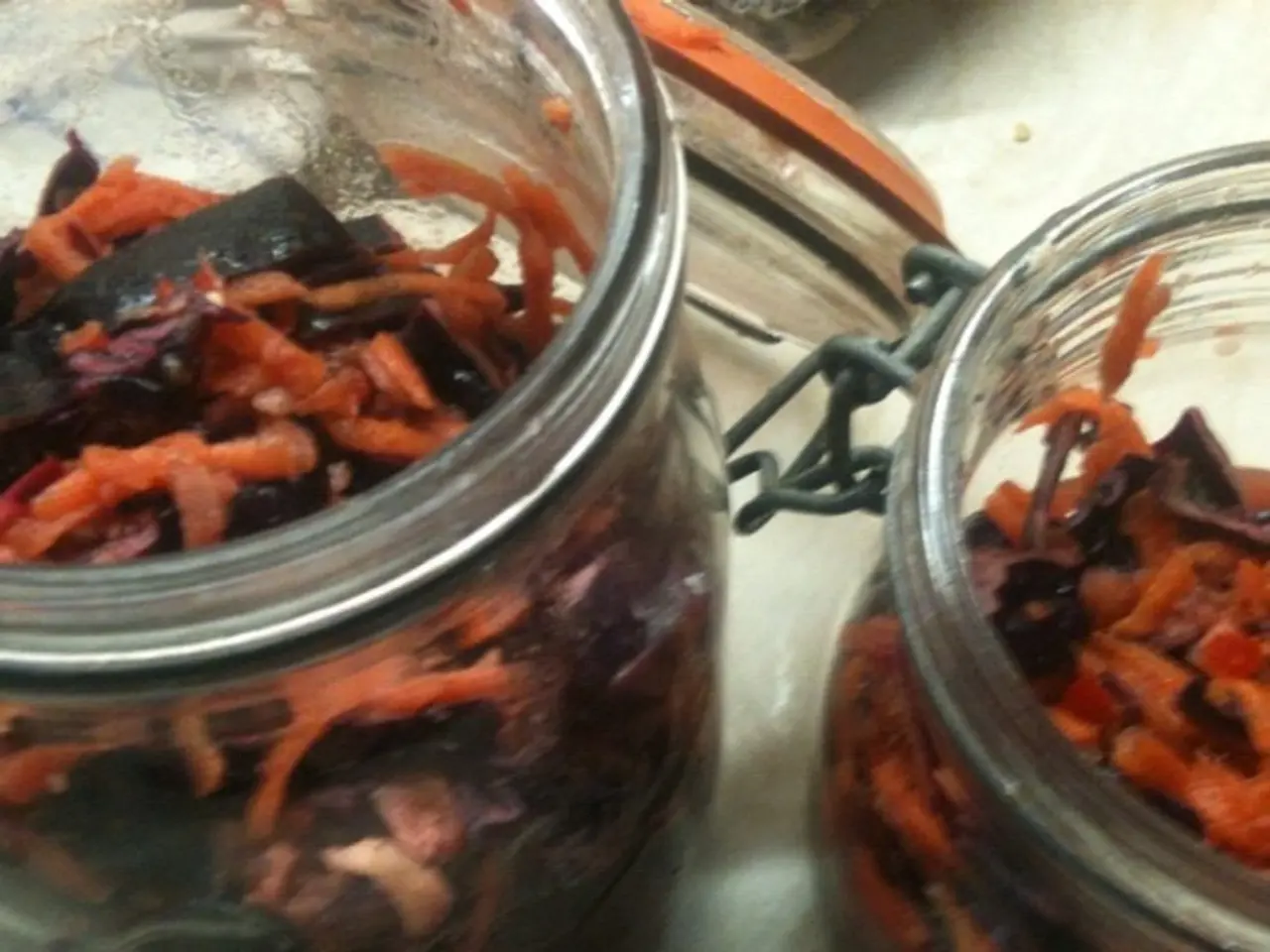Differences Within Fermentation and Pickling Processes
Lacto-fermentation and canning are two popular methods of food preservation, each with its unique advantages and characteristics. Here's a comprehensive look at these methods, focusing on their differences in nutritional value, taste, texture, safety, and equipment requirements.
Nutritional Value
Lacto-fermentation enhances the nutritional content of foods by promoting beneficial bacteria (probiotics) that improve gut health and can increase bioavailable vitamins. In contrast, canning preserves food mainly by heat processing, which can reduce some heat-sensitive nutrients but maintains overall nutrient preservation without adding probiotics [1][3][4].
Taste
Lacto-fermented foods have a distinctive tangy, sour flavor resulting from lactic acid produced by microbes during fermentation. Canned foods usually taste as cooked, with flavors mainly reflective of the original food and any added seasonings but lack fermentation’s sourness [3].
Texture
Lacto-fermentation tends to maintain or slightly soften texture while keeping foods crisp if done properly. Canning often softens food more because of the high heat involved, which can break down cell structures more extensively [3].
Safety
Both methods are safe when done correctly. Canning uses heat to kill pathogens and seal jars airtight, ensuring long shelf life without refrigeration. Lacto-fermentation relies on beneficial bacteria to create an acidic environment that inhibits harmful microbes. However, fermentation requires careful control (e.g., correct salt concentration, anaerobic conditions) to avoid spoilage [3].
Equipment Required
Lacto-fermentation requires minimal equipment—mainly clean jars and a way to keep the vegetables submerged in brine—and uses no electricity. Canning requires specialized equipment like a pressure canner or water bath canner, heat source, and sterilized jars with lids. Canning also often involves electricity or gas for heating [1][3][4].
A table summarizing these differences can be found below:
| Aspect | Lacto-Fermentation | Canning | |------------------|-------------------------------------------|---------------------------------------------| | Nutritional Value| Enhances with probiotics, may increase vitamins | Preserves nutrients but no probiotics | | Taste | Tangy, sour, complex due to fermentation | Cooked, original flavors, no sourness | | Texture | Crisp to slightly softened | Generally softer due to heat | | Safety | Safe if proper fermentation conditions met | Safe via heat sterilization and sealing | | Equipment | Clean jars, brine, no electricity needed | Pressure/water bath canner, heat source, jars, electricity or gas |
In conclusion, lacto-fermentation is a low-tech, probiotic-enhancing preservation method with a distinctive taste and texture, while canning is a heat-based method focused on long-term shelf stability without probiotics [1][3][4].
It's essential to note that while canning presents some risks, particularly when low-acid foods are canned, as it can lead to botulism, both fermentation and canning are accessible and easy to do at home for preserving fruit and vegetables safely.
Lastly, it's crucial to remember that pickling is not fermentation; pickling uses vinegar and heat to kill microorganisms, while fermentation allows natural bacteria to create lactic acid. Fermented foods become more refined over time, and with lacto-fermentation, vegetables tend to soften over time, changing the taste of food to salty, sour, and more nuanced flavors.
References:
[1] Sanders, D. (2011). The Art of Fermentation. Center Street.
[3] Hertzberg, J., Vaughan, L., & Reid, G. (2010). Putting Food By: Fifth Edition. Chapters Publishing Ltd.
[4] Katz, S. (2012). Wild Fermentation: The Flavor, Nutrition, and Craft of Live-Culture Foods. Ten Speed Press.
- Lacto-fermentation, contrary to canning, boosts the nutritional content of foods by fostering beneficial bacteria, which can aid gut health and enhance bioavailable vitamins.
- Lacto-fermented foods have a distinct tangy, sour flavor due to lactic acid produced during fermentation, whereas canned foods tend to taste as cooked, reflecting the original flavors and any added seasonings but lacking fermentation's sourness.
- While both methods are safe when done correctly, lacto-fermentation relies on beneficial bacteria to create an acidic environment and inhibit harmful microbes, whereas canning uses heat to kill pathogens and seal jars airtight.
- Lacto-fermentation requires minimal equipment, such as clean jars and a brine solution, whereas canning necessitates specialized equipment like pressure or water bath canners, a heat source, and sterilized jars with lids, often involving electricity or gas.




